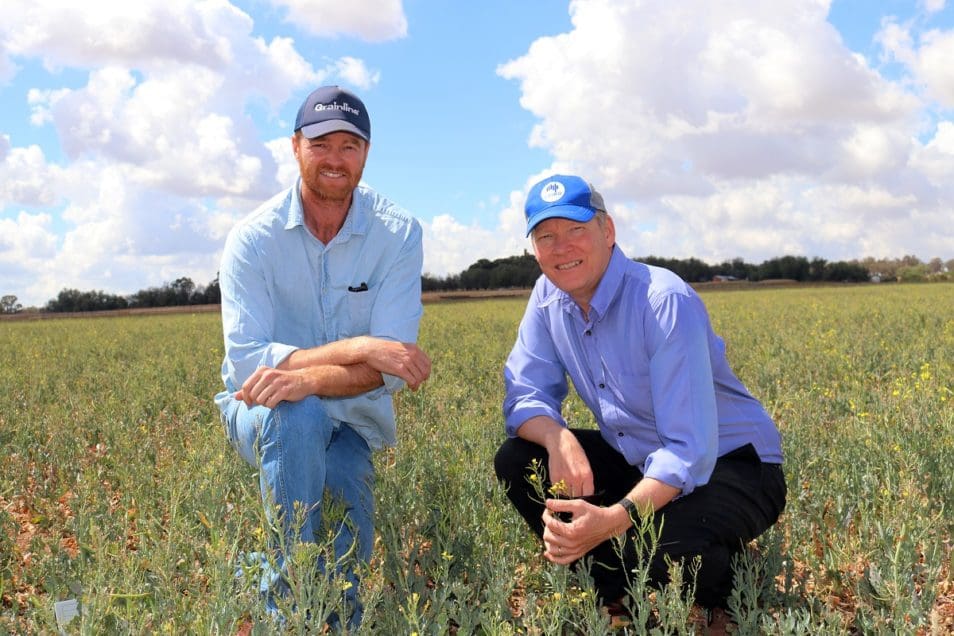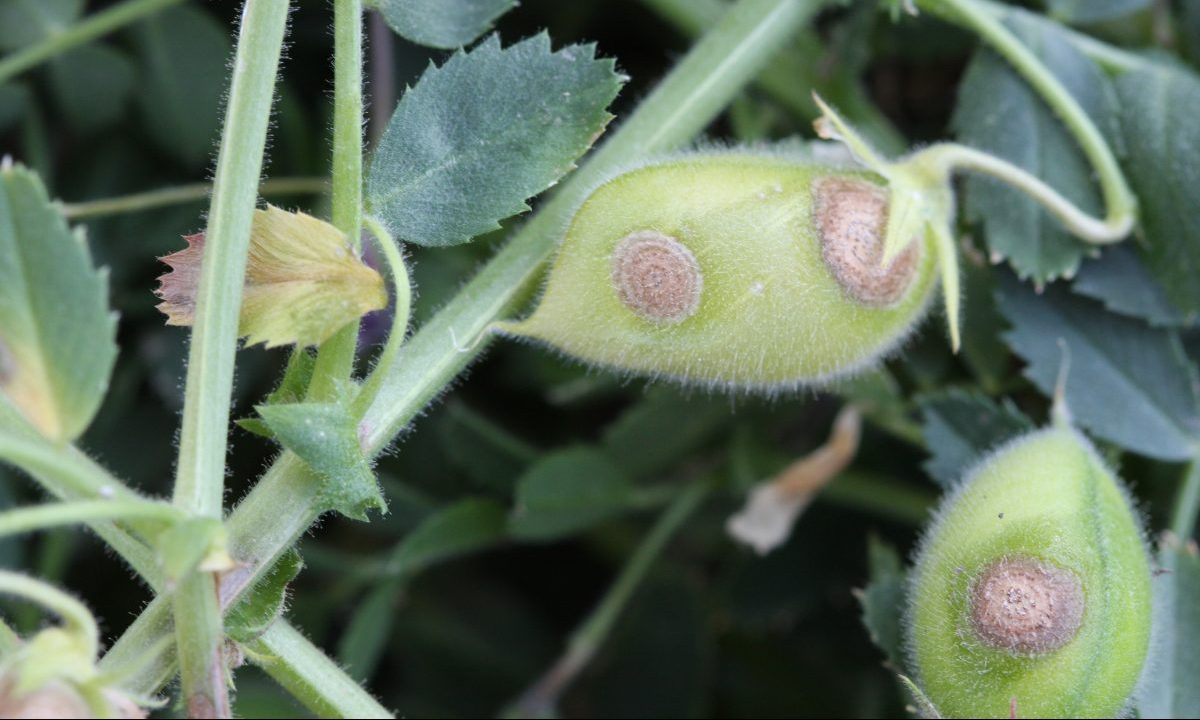
Greenethorpe grower Nick Kershaw and CSIRO researcher John Kirkegaard at Iandra. Photo: CSIRO
A DOUBLE-BREAK rotation incorporating a legume crop can be more profitable than a traditional cereal-canola system if measured across the full three-year cycle, according to early research results from the CSIRO.
CSIRO Agriculture and Food research scientist John Kirkegaard told the GIWA Pulse Forum last week that the reduced fertiliser costs and improvements both to weed numbers and to the following canola crop made the inclusion of legumes beneficial when viewed long term.
Dr Kirkegaard and a team of CSIRO scientists working in conjunction with the New South Wales Department of Primary Industries, consultants and growers are five years into a project which is investigating the possible advantages of introducing a legume to a cropping rotation at four NSW sites.
He said the diverse three-year double-break legume-canola-wheat rotation was compared against a baseline system of barley-canola-wheat with two levels of nitrogen application classified as conservative and aggressive.
The legume crop used depended on the site and soil type, and has included chickpeas, lentils, lupins, field peas, faba beans and vetch.
“The most profitable thing over the first three-year phase – we are half-way through the second phase now – was one of the diverse systems with the low-nitrogen strategy,” Dr Kirkegaard said.
“It was $100-$300 per hectare per year extra profit over and above the baseline.
“This was for two reasons; we had two howling droughts and then a very wet year, and right across those years, there were legumes that were competitive in their profitability with wheat and canola.
“We can’t beat the canola in the wet years…but remember we are looking at things over three years and phasing them.
“The second reason why the legumes were profitable was they were giving this boost in nitrogen and in water in the dry seasons to the following crops.
“We were picking that up in not having to apply so much nitrogen to following crops.”
Dr Kirkegaard said these gains were measured at about an extra 50 kilograms of nitrogen per hectare and 30 millimetres of water at depth.
He said applying extra nitrogen to the baseline rotation did not match the legumes in the financial outcomes, and the diverse rotation still came out on top.
“With urea prices and canola prices as they were for most of this project, we were saving about 78kg in urea per hectare which is valued at $47/ha then, and we were getting about 0.2-tonne benefit in our extra canola yield which, at those canola prices, was $143/ha.”
| Prices | Urea saving | Extra canola yield | Total value ($/ha) | ||
| (kg/ha) | Value | (kg/ha) | Value | ||
| Urea $600/t, Canola $650/t |
78 | $47/ha | 220 | $143/ha | $190/ha |
| Urea $1200/t, Canola $650/t |
78 | $94/ha | 220 | $143/ha | $237/ha |
| Urea $1200/t, Canola $1000/t |
78 | $94/ha | 220 | $220/ha | $314/ha |
Table 1: CSIRO researchers estimated the change in profits from a diverse rotation as canola and urea prices increased. Source: CSIRO, John Kirkegaard
He said herbicide use also declined with weed and disease incidences in the diverse rotation lower or comparable to the baseline system.
“Often [the benefits] are difficult for growers to see because if you focus just on this year, pulses will almost never be as profitable as canola, because it is a wet year, and if you focus on just the next year you often don’t see these longer term effects on weeds, diseases, nitrogen and so forth.
“You need to be at it a while to fully see the benefits and you need to keep checking that they are there.”

Legumes can be a difficult crop to grow, with many types suffering diseases, such as chickpeas with Ascochyta blight. Photo: GRDC
Results not guaranteed
Dr Kirkegaard warned growers that these early results were not always replicated, and the issues with legumes in some conditions did showcase the barriers with growing this type of crop.
He said, unlike canola, very few legumes are widely adapted to a range of soil types, which made the growing outcomes and disease incidences highly variable.
“We do get disease epidemics come through.
“They are a heart-breaking crop sometimes to grow, either because prices drop or because you get a wet season, and your yield is looking good then you’re out spraying fungicide.”
In one case, a trial chickpea crop sustained early Ascochyta damage then low-temperature stress, then lodging and then was hit with sclerotinia, Ascochyta and botrytis.
Dr Kirkegaard said the nitrogen benefits of a legume crop were also not guaranteed and required “good agronomy” practices to maximise fixation.
“It is not just a matter of scratching in a legume and magically it produces nitrogen.
“Yes, they can be profitable, and they can fix a lot of nitrogen, but they won’t always.
“There is an enormous variability in the amount they fix because they have to have a good nodulation, and they have to be grown healthily if you really want them to do that job.”
He said these problems can come if either there is something restricting the legume growth, such as sub-soil constraints, drought, herbicide residues or low phosphorus, or there are factors holding the rhizobium back, like acid soils or high mineral nitrogen in the soil.
Dr Kirkegaard said he said there were opportunities through breeding and growing strategies to improve outcomes for growers and hopefully make the crop more reliable into the future.
“Being pretty agnostic about legumes coming into this project…the agronomic benefits and the system benefits and the environmental benefits are there if we can crack some of these barriers then I think there will be some real wins.”
Grain Central: Get our free news straight to your inbox – Click here

HAVE YOUR SAY